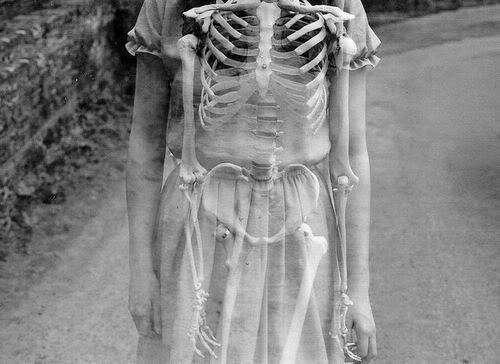The skeleton represents the inner fears within you that you cannot escape.
Surprisingly, I felt that this poem was actually relevant to our lives and something that I could actually relate to compared to other poems by Emily Dickinson. I admired Dickinson's use of metaphors and her careful use of diction which all serve a purpose to convey the message of how you can never escape from your own mind but you can always run away from other people. Through this poem, she made the message more tangible by describing chambers and houses as something with solid walls that you cannot penetrate through and there are no doors available to exit out of the confinements of your own mind and fears. To further analyze this poem, I will answer the following questions.
Outline the poem to show its structure and development/Point out examples and explain any metaphors
The first stanza of the poem describes physical structures such as chambers, houses, and corridors. The speaker states that "One need not be a Chamber-- to be Haunted--One need not be a House--". The word "haunted" gives a feeling of horror along with the word "chamber". However, the line claims that there are other forms of horror and it is not always confined by physical walls. Furthermore, "The Brain has Corridors--surpassing Material Place--", so it is essentially the opposite of a chamber and a house because there are multiple corridors which extend beyond material walls and confinements. The brain is a metaphor for all of the intangible fears and abstract thoughts in your mind that you cannot run away from.
In the second stanza, the poem then mentions how it's safer to confront and "External Ghost" during midnight than confronting "That cooler Host". The external ghost is something physical or someone who you fear and you're able to escape from. However, the "cooler Host" is the person inside of you. I feel like the word "cooler" gives a darker sense of horror because it's inside of you that you can't confront. The fourth stanza is very similar to the second stanza because it compares inner horrors/fears to an external fear: "Ourself behind ourself, concealed--Should startle most--Assassin hid in our Apartment Be Horror's least--". Our inner fears are hidden within ourselves compared to external fears which are assassins planning to kill us while we're in our apartments. The poem then transitions to the last stanza which is "He bolts the Door-- O'erlooking a superior spectre--Or More." The "He" represents the body who bolts the door trying to escape an external fear but then overlooks a superior ghost or a superior fear which is the fear/horror inside of him. Therefore, although we can always run away from external fears, our inner fears will always remain with us no matter what door we choose to exit through.
What is the tone of the poem?
I feel that the tone of the poem is dark and haunted especially through the use of ghosts as metaphor for our fears. Even chambers gives a sense of being haunted and the use of assassins and a revolver implies murder and killing.
Discuss the form or pattern of the poem.
There is a pattern of using confined infrastructures as something that can seemingly be haunted when you assume that ghosts or assassins are all around you, similar to how children are scared of monsters under their bed. However, Dickinson always contrasts those external fears to inner fears which emphasizes the greater darkness and horror of what lies within you.
Criticize and evaluate the poem.
For the most part, this poem is fairly straight-forward and I think Emily Dickson could make the central purpose more convincing by adding a different dimension to fear other than simply contrasting internal and external fears. The poem currently demonstrates fear as two opposite ends of a spectrum, but doesn't explain the grey areas in between the "black and white".

